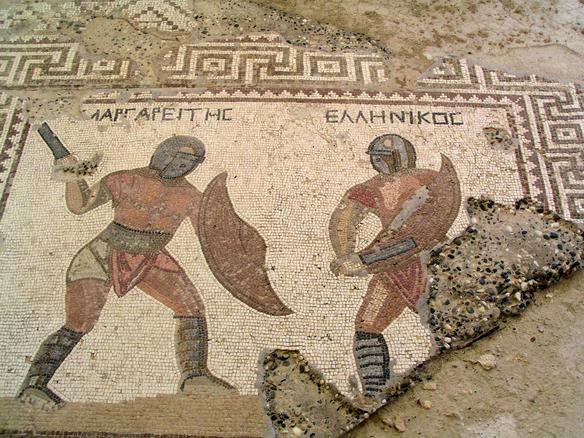



Source: Wikimedia Commons
Though many ancient Romans lived very hard lives, there were still plenty of options for entertainment. This ranged from music and theatre to more bloody past times like the gladiator arena. Read through the resources below to learn more.


Marble relief commemorating either the release from service or the discharge after a draw of two female gladiators, Amazon and Achillia. They are armed, and advancing to attack, with swords and shields. The figure on the right is missing the head. They stand on a platform, and below on each side is the head of a spectator. Inscribed above and on the platform. They are shown with the same equipment as male gladiators, but without helmets.

An oblong block of white marble, with a joint on the right side and on the top. The back of the block has been sawn off. There are three lines of inscription, in Greek. This is a fragment of a list of gladiators ranged under the two classes called Essedarii and Mormillones. After the name of each gladiator follows tthat of Hekataia, the lady who owned the band.

Pottery: rim and part of wall of Gaullish Sigillata bowl; moulded decoration: band of ovolo and dart below which is main scene comprising scenes of circus combat: standing gladiator (?) attacked by springing lion and on right armoured figure attacking another figure (now missing); slip very worn on figures and around rim.


Bottom of a drinking vessel; glass; with parts of the thin transparent sides still remaining. On the circular bottom, which has a blue background, is a gladiator holding a sword and trident; his loin-cloth is of silver foil with indented edges, and his belt is outlined and ornamented in red; one arm is tightly bound with leather thongs, and his body is partially covered with armour; behind is a windbag for practising boxing, and on it are two crossed swords; round the field is an inscription.

Bronze figure of a gladiator (retarius) holding a trident.

Copper alloy figure of a Thracian gladiator, wearing a loin cloth with protective waist-belt, helmet, and armoured guards for his shins, sword arm and shoulder.

Bronze votive offering in form of gladiatorial helmet.
Everted, unworked, knocked-off rim; slightly irregular and oval-shaped body with vertical sides; convex undercurve with low base ring; flat but uneven bottom. A continuous mold seam runs from rim, down sides (concealed by palm fronds), and across bottom.
On body, two friezes run around the sides; the upper and narrower frieze contains four names, widely spaced; the lower frieze, flanked above and below by a horizontal ridge, is broader and comprises two scenes divided by vertical palm fronds, each containing two pairs of gladiators in varying stances with four names inserted between them at the top of the scenes.
Broken and repaired, but with some losses to rim and body; a few pinprick and larger bubbles, and a few gritty impurities; slight dulling and pitting, and faint iridescent weathering.
The scene around the cup depicts four pairs of gladiators fighting. Each man is identified by name in the Latin inscription above him. Some of the names match those of known gladiators who became famous in games held in Rome during the Julio-Claudian period, suggesting that such cups may have been made as souvenirs.
The gladiator wears protective body armor and carries a shield and short sword. He can be identified by the helmet with eyeholes as a secutor, who was usually matched against a retiarius wielding a trident and net. Such a pair mimicks the contest between a fish and a fisherman.
In addition to a central crest, gladiators’ helmets often had feathers attached above the ears. The holes for such ornaments are faithfully reproduced on this helmet-shaped lamp.
Relatively few painted glass vessels have survived from antiquity. This example, although sadly incomplete, is decorated in a rich palette of colors with lively scenes representing gladiators and wild beast fights.
Loeschcke Type 1A. Mold-made. Deep, concave discus: two gladiators fighting; the one on the left, who lunges forward to right but with head turned back left over his right shoulder, wearing a crested helmet, holding a large rectangular shield at his left side, and aiming a short sword or dagger in his raised right hand at his opponent; the gladiator on the right faces right, away from his attacker, wearing a crested helmet and greaves, with his curved sword and smaller shield lowered; a single filling hole towards bottom between the gladiators, and a band of lines and grooves on almost horizontal shoulder. Volutes flanking nozzle, with large wick hole. Incised base ring, and flat base.
Gladiatorial shows were essentially a Roman phenomenon, but their popularity quickly spread to the Greek cities of the eastern part of the Empire. This fragmentary relief with its Greek inscription is evidence for the existence of gladiators in the Greek-speaking world. The scene shows two types of gladiators pitted against each other in the arena.
In the Imperial period, there were seven main types of fighter; each was known by a different name, wore distinctive armor, and carried specific weapons. Most were heavily armed and wore helmets; these were the murmillo, thrax, hoplomachus, provocator, and secutor. In addition, there were the eques, who only fought against another eques since the contest started on horseback, and the retiarius, who was lightly armed with a trident, wore no helmet, and carried a net. Here a retiarius is being pursued by a secutor, and behind them to the left is part of the stage scenery or props that often featured in the games.


 The Roman gladiators
by
The Roman gladiators
by